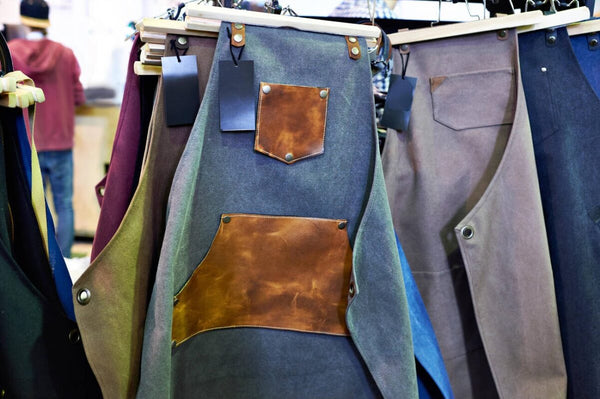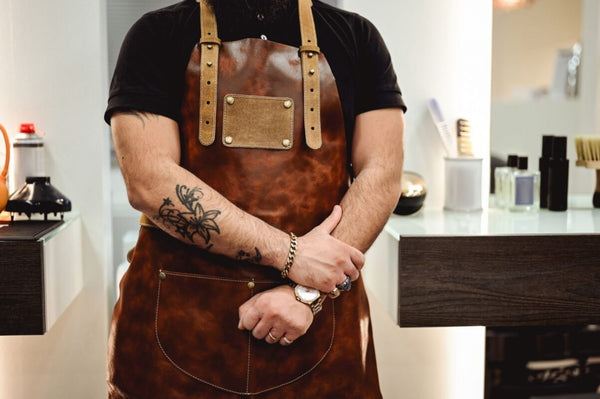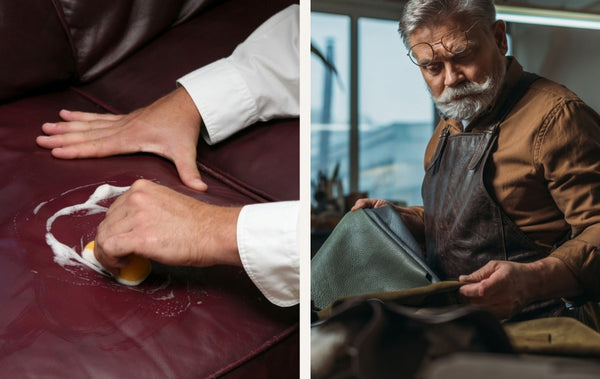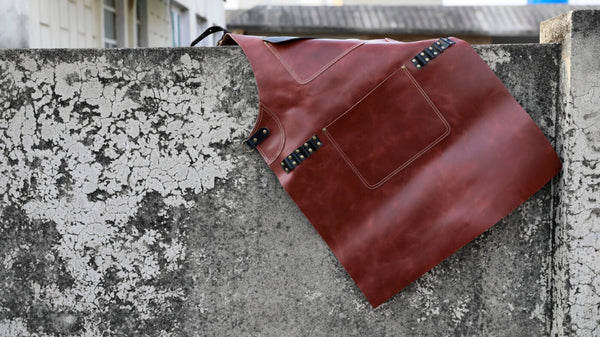Leather aprons are a popular choice for many professionals, including butchers, chefs, blacksmiths, and woodworkers. These aprons are popular because of their durability, protection, and timeless design. However, leather aprons, like any other kind of leather product, need to be properly cared for and maintained in order to keep their quality and last for a long time. In this blog, we’ll tell you how to keep your apron looking and feeling its best by cleaning and protecting it. These guidelines will assist you in preserving the appearance of your apron and extending its lifespan, regardless of whether you use it for work or leisure. So, let’s get started with the types of these aprons
Types of Leather Aprons

There are several types of these Leather aprons available in the market, and it’s essential to understand their differences to choose the best one for your needs. Here are some of the most common types
Full-grain aprons of Leather – These aprons are made from the top layer of the animal hide and are the most durable and expensive type. These aprons can withstand heavy use and are resistant to scratches and stains.
Top-grain aprons of Leather – These aprons are made from the second layer of the animal hide and are slightly thinner and more flexible than full-grain ones. Top-grain aprons are also more affordable than full-grain aprons.
Split-grain aprons of Leather – These aprons are made from the bottom layer of the animal hide and are the least expensive and least durable type of aprons made of leather. Split-grain aprons are more susceptible to damage and require more frequent maintenance.
Suede aprons – These aprons are made from the inner layer of the animal hide and have a soft, velvety texture. Suede aprons of leather are not as durable as full-grain or top-grain aprons and require more care.
A full-grain or top-grain apron is a great investment if you need a durable and long-lasting apron, while a suede or split-grain ones are a more affordable option for occasional use.
Protecting Your Cowhide Apron

To keep your apron looking its best, it’s essential to protect it from damage. Here are some tips for protecting your apron:
1- Use a leather protectant or wax to create a barrier between the leather and the environment. This coating can help repel water, prevent stains, and reduce scratches and scuffs.
2- Leather can crack and dry out when exposed to excessive heat. Avoid leaving your apron in direct sunlight or near a heat source, such as a stove or fireplace.
3- Aprons made up of leather are designed to protect against cuts and punctures, but they are not invincible. Keep your apron away from sharp objects that could damage the leather, such as knives or nails.
4- When not in use, store your apron in a cool, dry place to prevent mold and mildew growth. Avoid storing it in a plastic bag, as this can trap moisture and damage the leather.
Cleaning Your Apron of Leather!
Cleaning your leather apron is crucial to maintain its appearance and quality. However, it’s important to clean it correctly to avoid damaging the leather. Here are some tips for cleaning them:

1- Using a soft brush:
Start by removing any dirt or debris from the leather surface using a soft-bristled brush. Avoid using abrasive brushes or sponges that could scratch the leather.
2- Spot clean stains:
If you have a stain on your apron, use a damp cloth with a mild soap solution to gently spot clean the area. Be sure to rinse the soap off with a clean, damp cloth and dry the apron thoroughly.
3- Avoid harsh chemicals:
Avoid using harsh chemicals or solvents, such as bleach or acetone, to clean your apron of leather, as they can damage the leather’s surface and finish.
4- Condition the leather:
After cleaning, apply a leather conditioner to keep the leather supple and prevent cracking. Follow the manufacturer’s instructions on the conditioner and apply it evenly to the apron’s surface.
5- Allow it to dry naturally:
After cleaning and conditioning your apron, allow it to air dry naturally. Avoid using heat or direct sunlight to dry the leather, as this can cause the leather to crack or become discolored.
By following these tips, you can keep your apron of leather clean and in excellent condition for years to come. Remember to clean it regularly and condition it after each cleaning to keep the leather supple and prevent cracking.
Maintenance Tip

Maintaining your leather apron is essential to keep it in good condition and extend its lifespan. Here are some maintenance tips to follow:
1- You must Regularly inspect your apron for any signs of damage, such as cuts, tears, or cracks. If you notice any damage, repair it immediately to prevent further damage.
2- You should reapply the protective coating. Over time, the protective coating on your apron of leather may wear off. Reapply the protective coating or wax to keep the leather protected from the environment.
3- You should avoid getting it wet more often. Leather can become damaged when exposed to water, so avoid getting your apron wet. If it does get wet, dry it immediately with a clean, dry cloth and allow it to air dry.
4- Store your apron in a cool, dry place away from direct sunlight. Avoid storing it in a humid or damp environment, as this can cause mold and mildew growth.
5- Aprons made up of leather are designed for specific uses, such as cooking or woodworking. Avoid using your apron for activities that could damage the leather or compromise its protective properties.
If you follow these care instructions, your cowhide apron will last longer and remain in excellent condition. A leather apron, on the other hand, is a stylish and long-lasting accessory that must be properly cared for to remain in good condition. It can be protected from damage, cleaned effectively, and maintained to extend its lifespan if you follow the advice in this blog post. Be sure to check your apron on a regular basis for damage, keep it out of harsh environments, and store it properly when not in use. You can enjoy your cowhide apron for years to come while preserving its appearance and functionality by following these steps.
